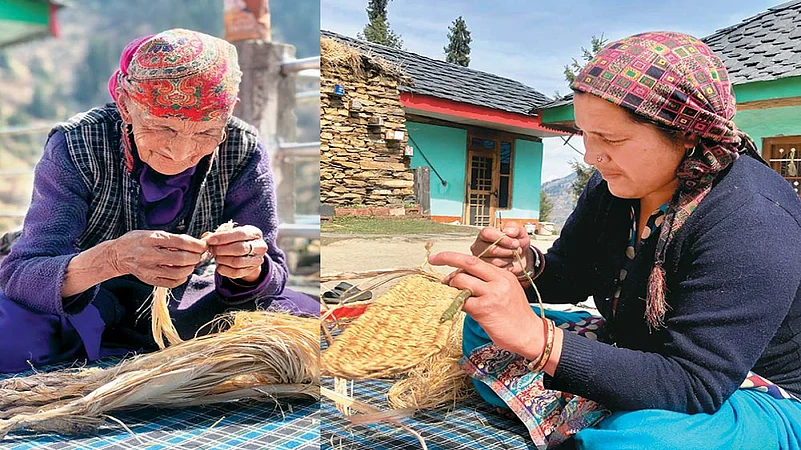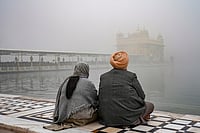The slim, sharp leaves with serrated edges, and their opiate offspring, have a sly cachet around the world—symbol of counterculture and ‘free love’, or cool accessory of safely wannabe radicalism, best taken with a T-shirt depicting a beret- and beard-wearing revolutionary. In the Himachal Pradesh resort of Kullu, the dizzying variety of byproducts—cannabis, marijuana, hashish and hemp—is both common currency and, for most frequenters of this ‘little Amsterdam’, the town’s raison d’être. Indeed, café owners and the peddlers who skulk about them are charmingly blasé about the narcotics trade. It’s here, too, in the Parvati Valley, that the (in)famous Malana cream—the choicest hashish, say connoisseurs—is produced. Illegal cultivation of cannabis is a hard reality in the inaccessible mountain valleys of the area—and a major cause of worry for state agencies, especially the police.
There have been various proposals to liberate picturesque and tourist-friendly Kullu from the icy grip of the drugs trade. The obvious solution, it now appears, lies in an antidote of the same virus coursing through the veins of the valley. Because, as many sober persons know, hemp (a non-narcotic form of cannabis) can be used in the manufacture of a wide variety of products—from medicines, cloth and cosmetics to rope and ink; from detergents to soaps. Thus, when Chief Minister Jai Ram Thakur announced in the state assembly a move to legalise cultivation of hemp/cannabis, the relief was palpable. “Commercial hemp cultivation is permitted and regulated in many countries and in some states in India. This creates investment and employment opportunities. The state government proposes to frame a policy to permit commercial hemp cultivation with proper regulatory framework,” Thakur announced during his budget speech on March 6. The geo-climatic conditions in Himachal Pradesh are best suited to hemp cultivation for medicinal and agricultural use.
On the previous day, March 5, the assembly debated the benefits of allowing commercial cultivation of hemp. Many legislators—the BJP’s Ramesh Dhawala proved to be the most enthusiastic—spoke forcefully about how the move would give Himachal’s Covid-hit rural economy a boost, thus opening an alternate way to the cultivation of hemp in Kullu, Mandi and Chamba districts. Agreeing with Dhawala, the CM recalled how, as a sitting MLA some years back, he had moved a private members resolution favouring such a policy.
“As a child,” Thakur said, “I have seen how hemp was useful food in the cold winters. There are multiple household usages too. The shail (fibre) is still used to make ropes, mats, footwear. Cannabis oil was used in winters for body lotion because of its high medicinal and energy values. Its seeds are an important ingredient to make Siddu, the famous Himachali bread.”
In 1985, India banned the cultivation of cannabis plants under the Narcotic Drugs and Psychotropic Substances (NDPS) Act. But the law allows state governments to allow controlled cultivation of hemp for obtaining its fibre and seed for industrial/ horticultural purposes. In 2018, Uttarakhand became the first state to allow the cultivation of only those strains of cannabis plants which have a low concentration of tetrahydrocannabinol (THC)—the primary psychoactive constituent of cannabis.
Indeed, the Palampur-based Institute of Himalayan Bioresource Technology (IHBT) has been requesting the Himachal Pradesh government to approve the cultivation of hemp in the state in view of its large industrial demand. The move will revolutionise the farm economy and empower local communities, including women, the IHBT wrote to the government last year.

Devan Khanna, a Shimla lawyer who has long demanded a law that allows hemp cultivation, says, “There is great opportunity that local farmers can seize for their benefit. Industrial Hemp (Cannabis sativa L.), is a non-drug cannabis with THC content generally below 0.3 per cent. Thus a potential source of income has remained untapped. Hemp seeds and hemp seed oil has huge demand for its medicinal properties. Farmers have a right to its benefits.”
Khanna says he has already worked on a draft law, which has since been submitted to the government to help it frame the policy. A single village that can grow hemp and has a tie-up with industry, says Khanna, can earn as much as Rs 2 to 3 crore per annum.
But, beside prospects of path-breaking change lies ingrained, age-old culture that enmeshes man with nature. It’s patently visible at Gadagushaini—a small hamlet around 80 km from Kullu. Here, talk about hemp doesn’t evoke images of a psychotropic haze. In this ‘little Himachal’, it has been in use since the dawn of civilisation as food, medicine, in ceremonies, rituals, customs, and household usage. The womenfolk use shail to make ropes, shoes, bags and mats. Every part of the plant is used—the root, stem, leaves, fruit, seeds. In fact, narcotic use of cannabis/bhang is treated with contempt in these parts of Kullu and Mandi districts. Surreptitious supply to domestic/foreign tourists is unthinkable.
TheWoolKnitters, a Kullu-based initiative promoted by social activist-cum-entrepreneur Shivani Thakur and NIFT graduate Akshita Sharma, has trained and thus empowered local women in the use hemp fibre for the manufacture of innovative products using new designs. These products, ranging from pullas (hemp slippers), hemp socks, woven hemp fabric, and knitwear—all involving exquisite embroidery and craftwork, now has a huge demand in the international markets. Indian fashion houses are also huge buyers.
“We have started making knitwear with an aim to uplift women economically and professionally. The aim is to make many of them economically independent. These women are dedicated to create products that are timeless, kind to the environment and our own community,” says Shivani.
Besides tending to basic needs of cooking and cleaning for the family, these women villagers spend their days feeding cattle, labouring in farms and collecting wood for the chilling winter months, when their world is wrapped under sheets of snow. Traditional craft using hemp fibre, of course, persists. Sitting in groups under a warm sun, women can still be found weaving fabric, using a needle and hand-twisted hemp fibre, as their forebears have done for centuries.
“Our product aims to preserve their craft and their sense of community. The products are eco-friendly, durable, odourless and biodegradable. Hemp slippers have been used over the years for its acupressure/reflexology qualities due to the texture and its anti-bacterial property that prevents odour,” Shivani explains.
Taking its cue from such ventures, a few young Himachali entrepreneurs are planning hemp-based start-ups in places like Kangra, Mandi and Kullu. Industrial and pharma groups are also ready with plans the moment the state government gives a green signal.
Any residual cause for worry is allayed by Satya Prakrash Thakur, chairman of the cooperative Bhuttico, a reputed weavers society: “I don’t favour any laxity to the illegal narcotics trade in the garb of cannabis/hemp cultivation. I certainly favour allowing non-narcotic varieties, which will hugely benefit local farmers.” The nascent industry would certainly need watchful guardians like Thakur, a former Himachal horticulture minister hailing from Kullu, which is likely to become a hub of the hemp trade.


























